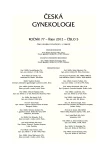Course of congenital malformation incidences and their changes over time in children born in the Czech Republic
Authors:
A. Šípek 1,2,3; V. Gregor 1,2,4; J. Horáček 1,5; A. Šípek jr. 6; P. Langhammer 7
Authors‘ workplace:
Oddělení lékařské genetiky, Thomayerova nemocnice, Praha, ředitel MUDr. K. Filip, CSc., MBA
1; Oddělení lékařské genetiky, Sanatorium Pronatal, odborný vedoucí doc. MUDr. T. Mardešić, CSc.
2; Ústav obecné biologie a genetiky 3. LF UK, Praha, děkan prof. MUDr. M. Anděl, CSc.
3; Katedra lékařské genetiky, Institut postgraduálního vzdělávání ve zdravotnictví, Praha, ředitel MUDr. V. Pavelka
4; Gennet, Praha, vedoucí MUDr. D. Stejskal
5; Ústav biologie a lékařské genetiky 1. LF UK a VFN, Praha, doc. MUDr. M. Kohoutová, CSc.
6; Ústav zdravotnických informací a statistiky České republiky, ředitel Mgr. J. Holub
7
Published in:
Ceska Gynekol 2012; 77(5): 424-436
Overview
Aim of study:
An analysis of incidences of selected birth defects in the Czech Republic in 2000 – 2008 period.
Type of study:
Retrospective epidemiological analysis of birth defects incidences in births and total birth defects incidences (including prenatally diagnosed cases) from the Czech National Birth Defects Register database.
Material and methods:
Data from the National Birth Defects Register (Institute for Health Information and Statistics) in the Czech Republic in the 2000 – 2008 period were used along with data on prenatally diagnosed defects from particular departments of medical genetics.
Sixteen selected defects (anencephaly, spina bifida, encephalocele, congenital hydrocephalus, coarctation of aorta, transposition of great vessels, hypoplastic left heart syndrome, Fallot tetralogy, omphalocele, gastroschisis, diaphragmatic hernia, oesophageal atresia and stenosis, anorectal malformations, Down syndrome, Edwards syndrome and Patau syndrome) were analyzed in detail.
Results:
There were 119 570 live births (61 326 boys and 58 244 girls) in 2008. In the same period, 4664 live births with a birth defect (under the age of one year) were reported, out of which 2754 boys and 1910 girls. Mean incidence was 390.06 (449.08 in boys and 327.93 in girls) per 10 000 live births. In 1994 – 2006, totally 1 238 398 children were born, out of which more than 42 000 with a birth defect. In the 2000 – 2006 period, absolute numbers of diagnosed live births with birth defect varied between 3600 – 3800 cases per year while in 2007 and 2008 years absolute numbers raised over 4600 cases per year. During 2000 – 2008 period following mean incidences (per 10 000 live births) of selected defects were ascertained (total incidences including prenatal diagnostics in brackets): anencephaly 0 – 0.3 (1.9 – 3.7), spina bifida 0.7 – 2.3 (3.2 – 5.2), encephalocele 0.1 – 0.4 (0.9 – 2.4), congenital hydrocephalus 1.6 – 3.5 (5.3 – 7.0), coarctation of aorta 3.9 – 5.2 (4.8 – 6.1), transposition of great vessels 2.9 – 4.5 (3.2 – 5.0), hypoplastic left heart syndrome 0.7 – 2.3 (2.2 – 4.3), Fallot tetralogy 2.6 – 4.0 (3.2 – 4.4), omphalocele 1.0 – 1.7 (1.8 – 3.8), gastroschisis 0.2 – 1.2 (2.4 – 3.4), diaphragmatic hernia 1.3 – 2.9 (1.5 – 3.9), Down syndrome 3.3 – 6.5 (15.8 – 22.2), Edwards syndrome 0.2 – 1.0 (3.5 – 5.8) and Patau syndrome 0.2 – 1.0 (1.2 – 2.6).
Conclusions:
There has been no major change in birth defect incidences in live births in the Czech Republic in last years. Number of non-viable defects has decreased in stillbirths and in perinatal mortality in the Czech Republic. An incidence of some defects has decreased mostly due to a nation-wide system of prenatal diagnostics; some incidences remain stable in live-birth population in others incidences have increased. A total incidence has mostly increased (anencephaly being an exception) mostly due to an earlier prenatal diagnostics. In chromosomal syndromes, an increasing maternal age as well as a growing number of mothers of 35 years of age and over has contributed to the increased incidences.
Key words:
birth defect, incidence, Czech Republic, anencephaly, spina bifida, encephalocele, congenital hydrocefalus, coarctation of aorta, transposition of great vessels, hypoplastic left heart syndrome, Fallot tetralogy, omphalocele, gastroschisis, diaphragmatic hernia, oesophageal atresia and stenosis, anorectal malformations, Down syndrome, Edwards syndrome and Patau syndrome.
Labels
Paediatric gynaecology Gynaecology and obstetrics Reproduction medicineArticle was published in
Czech Gynaecology

2012 Issue 5
Most read in this issue
- Outcomes of anterior vaginal wall repair using polypropylene mesh
- HE4 a biomarker of ovarian cancer
- Intrauterine system (Mirena) and ectopic pregnancy – case report
- Prevalence of Chlamydia trachomatis infection in patients treated for infertility
